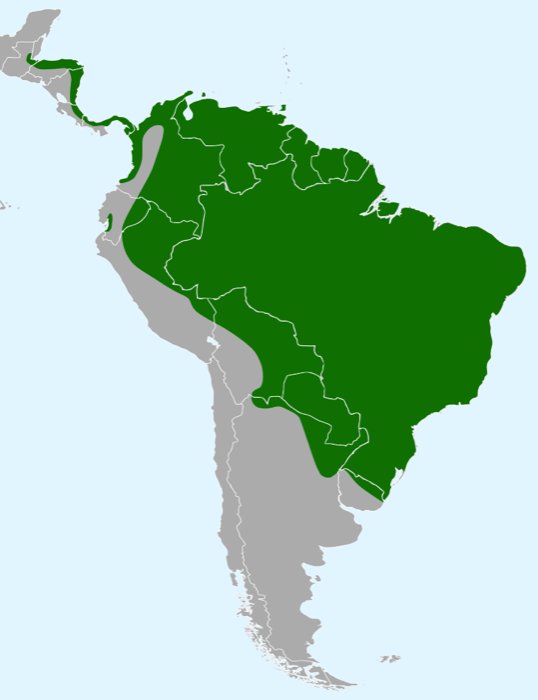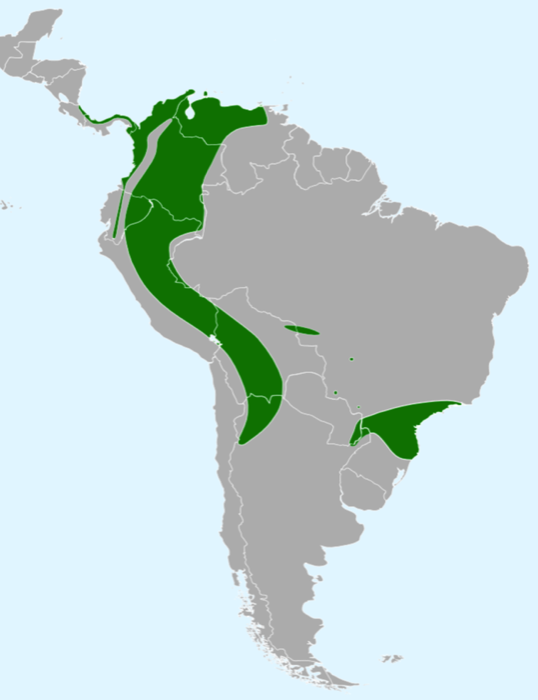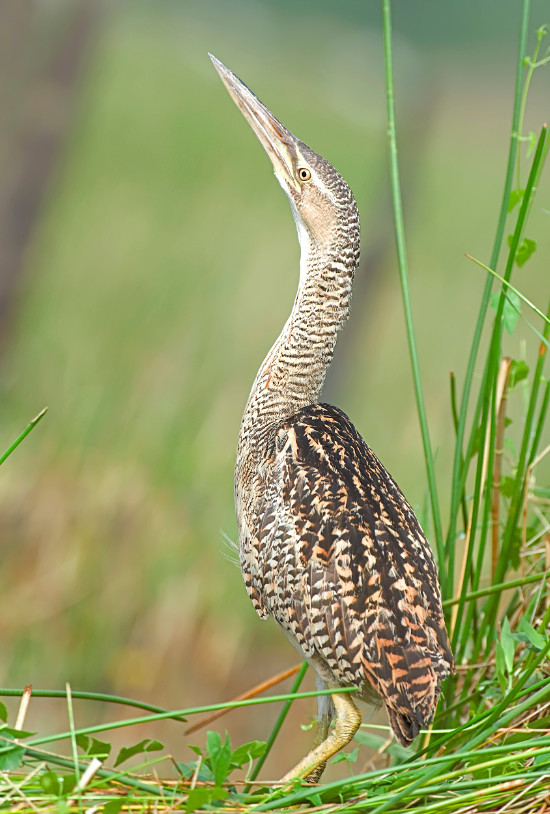Tiger Heron
Tiger Heron
Tiger Herons belong to the genus Tigrisoma. This is a combination of two Greek words: tigris, meaning "tiger" and somā, meaning "body". There are two species of Tiger Heron within the Pantanal - the Fasciated tiger heron (Tigrisoma fasciatum) and Rufescent tiger heron (Tigrisoma lineatum).
Tiger Heron
Aside from the distinctive red-brown colour covering their head, neck and chest area, Rufescent Tiger Herons have a white stripe which runs down the centre of their fore-neck. Their back and wings are grey but have a noticeable brown tint and faint barring also visible. The birds' belly and underparts are dull grey-brown. Juveniles don't develop their adult coloration until they reach around four years of age. Before that they have a less conspicuous mottled black and tan appearance, with whitish underparts. The heron's beak is dark grey, with bright yellow skin around the base of the bill and eyes.
Rufescent Tiger Herons have two subspecies: Tigrisoma lineatum lineatum occurs from southeastern Mexico through into the Brazilian Amazon and northern Argentina. Tigrisoma lineatum marmoratum occurs from the central region of Bolivia through into the east of Brazil and northeastern Argentina. This is the subspecies most likely to be encountered in the Pantanal.
The Fasciated Tiger Heron looks similar to the immature Rufescent Tiger Heron - being mottled in appearance with pheasant-like barring. However, Fasciated Tiger Herons are greyer and darker overall than Rufescent juveniles. For this reason they're locally known as Socó-Boi-Escuro (with "Escuro" in Portuguese meaning "Dark") as opposed simply to Socó-Boi which is the local name for the Rufescent species. Although it also has bright yellow facial skin, this is less prominent since the slate-grey coloration of feathers around the face offers less contrast. Adult birds have a solid black cap at the top of their head. The body and wings are tinged cinnamon-brown.
Behaviour and Habitat
Rufescent Tiger Heron
Although it prefers wooded areas close to rivers and streams, the Rufescent Tiger Heron is more tolerant of human encroachment. This is the species that's most likely to be seen along the major rivers and flat wetlands of the Pantanal. Besides the Pantanal, Rufescent Tiger Herons' range extends across most of South America from Colombia down to Uruguay and Northern Argentina. Their range also stretches upwards along the northern coast of Central America - through Panama, Costa Rica and into Nicaragua.
As expected for a species that spends most of its time foraging in and around water, its diet is large aquatic - taking fish, frogs, crustaceans, water beetles and dragonfly larvae. Since they're forest herons, they're feeding typically takes place alongside tree-lined rivers and streams, in marshes close to forest, or on floating vegetation. Rufescent Tiger Herons are generally solitary feeders - although feeding in pairs isn't unknown. As with other herons, it stays very still for long periods, then thrust its beak forward in a sudden stabbing motion when prey comes close. Herons will take insects and non-aquatic prey if presented with the opportunity but are less well adapted to take advantage of this.
Fasciated Tiger Heron
Aside from being rarer, the Fasciated Tiger Heron is more timid and harder to find. It typically prefers rugged territory around foothills and fast-running streams through stony or rocky terrain. This means that it's less likely to be encountered in the middle of the Pantanal - although there are isolated pockets in tablelands around the northern Pantanal such Ricardo Franco State Park in Mato Grosso, and other scattered areas. Outside of the Pantanal it can be found in stretches along the eastern slopes of the Andes, with limited populations also in rugged areas of south-east Brazil's Mata Atlântica forest.
In terms of behaviour, the Fasciated Tiger Heron is generally solitary - standing along the banks of fast-flowing rivers, or on boulders mid-stream. It is very sensitive to the presence of humans, and will retreat if disturbed. Since it prefers untouched wilderness areas with very clean unpolluted water, the presence of Fasciated Tiger Herons is seen as a good indicator for the health of the environment in which they reside. As with the Rufescent Tiger Heron, Fasciated Tiger Herons' diet consists primarily of fish and aquatic insects.
Scientific Name
Tigrisoma lineatum
Local Name
Socó-Boi
Description
Medium-sized heron about 60cm in length. Generally found along rivers close to forested areas - but occasional visitor to river ports around small Pantanal towns such as Corumbá. Adult herons have a distinctive red-brown colour covering their head, neck and chest area, with their body and wings appearing grey (but with a brown tint and faint barring also visible). Juveniles don't develop their adult coloration until they reach around four years of age. Before that they have amottled black and tan appearance.



Scientific Name
Tigrisoma fasciatum
Local Name
Socó-Boi Escuro
Description
Similar to the Rufescent Tiger Heron - but without the red colour, and slightly smaller. Has a grey mottled or barred appearance - with a blackish cap on fully developed adults. This is considerably rarer than the Rufescent Tiger Heron and is generally only found in upland rocky terrain with fast-moving rivers.
The Rufescent Tiger Heron is widely distributed across much of the South American continent. It's found primarily is lowland areas.
The range of the Fasciated Tiger Heron is more limited. In contrast to the Rufescent Tiger Heron, this species prefers fast-moving streams and rivers in upland areas.
A juvenile Rufescent Tiger Heron displaying it's mottled appearance. Although immature Rufescent and Fasciated Tiger Herons can be also identical, Rufescents may have a stronger red tint around the head and shoulders, whereas Fasciated Tiger Herons have a slightly shorter and more robust beak. Credit: Tony Castro.
Rufescent Tiger Heron with its adult coloration. This colouration develops at around four years of age. Credit: Cláudio Dias Timm.
Reproduction
Rufescent Tiger Heron
The breeding season for Rufescent Tiger Herons varies based on location - with northern-most herons (in Panama) beginning in April. Those in Suriname, Venezuela and northern Brazil breed in May-June - with the southern-most herons in Argentina breeding in December and January. This variation is likely due to climate - with observations that breeding typically coincides with the start or end of the dry season when food is most abundant. Within the Pantanal, the breeding season is Jul-Nov.
During the breeding season adult emits loud low-pitched hoots which have been compared to the panting of jaguars, or the bellowing of an ox. These vocalisations generally occur at night. Breeding pairs will exhibit courtship behaviour but this isn't well documented - although captive pairs have been observed stretching, bowing, and entwining necks. Unlike many other heron species that nest together in large colonies, the Rufescent Tiger Heron is a solitary nester - preferring tall trees in wooded areas close to water. Nests are a simple untidy platform of sticks about 50 cm in diameter. These are normally located several metres above the ground or water - but occasionally occur at low levels of less than 1 metre.
Breeding nests contain 2-3 eggs, described as very faintly blue or dirty-white, and are lightly speckled. These have an incubation period of 31 to 34 days. Of the eggs laid, typically only one will hatch and survive through to fledgling stage. The subsequent slow maturation (taking 3-4 years to reach adulthood) suggests that this is a long-living species that is likely sedentary. The young seem to be fed primarily at night. Adults will shade the young from the sun during the day.
Fasciated Tiger Heron
Due to its more restricted range and comparative rarity, little is documented about the reproduction of the Fasciated Tiger Heron. It's nest and clutch size, and vocalisations have been noted - with observations suggesting that these are similar to those for the Rufescent Tiger Heron species. Based on this, we can assume that the incubation period and other related behaviours are also similar.
Fasciated Tiger Herons lack the rusty red-brown colour around the head and upper body. They also prefer other habitats such as fast-moving streams in foothills. In this environment they're most likely to be encountered standing on boulders. Fasciated Tiger Herons have a black crown, although this only appears on adult birds. Credit: Gergo Nagy/Shutterstock.
Pinnated Bittern: Almost a Tiger Heron
Adult Pinnated Bitterns measure between 64-76 cm in length, weighing between 0.5kg - 1.2 kg. The sexes are visually identical - except that females tend to be smaller and have brown (instead of black) tail feathers. Both adults and juvenile birds are mottled brown and black, although the colouring of juveniles are more reddish. Unlike Tiger Herons, the Pinnated Bittern lack strong markings on their throats, although the throat and foreneck is lighter in colour. Pinnated Bitters are generally silent, but during the breeding period, males give a low-pitched muffled "poo-doo" or booming "poo" call. This occurs mainly at dusk or at night.
Breeding occurs in the wet season - with the Bitterns making nests in thick vegetation not far above the surface of the water. These nests are a simple platform or shallow cup constructed using sticks or plant stems. Once mated, the female lays a clutch of 2-3 eggs. It appears that it's only females which incubate the eggs, although both parents have been observed sharing responsibility to feed and nurture the juveniles. Chicks remain close to the nest until they learn to fly. As with Tiger Herons, Pinnated Bitterns nest away from other herons instead of in colonies.
Conservation and Threats
Quick Facts
- When alarmed or warding off threats, Tiger Herons make themselves bigger and more threatening by stretching their necks, ruffling their neck feathers and swinging their tail feathers.
- Tiger herons can feed on small snakes such as young anacondas. However, Tiger Heron nestlings and fledglings can also be prey for other bird species such as storks.
- There's evidence that Rufescent and Fasciated Tiger Herons were food items for indigenous peoples - with remains having been discovered at archaeological sites across the species' range.
RELATED LINKS
Banner image: Two Rufescent Tiger Herons (Fernando Flores/Wikimedia)





